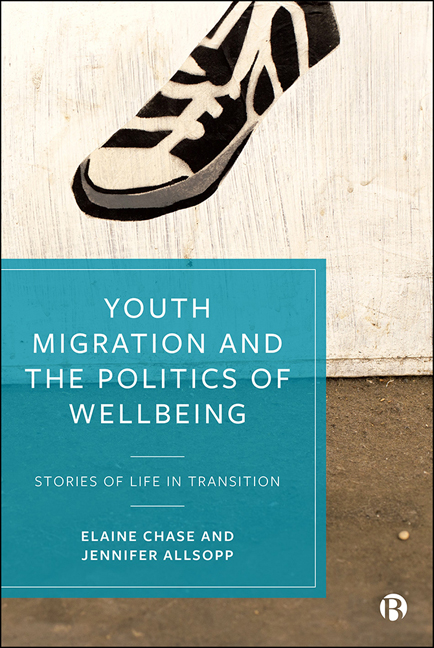Book contents
- Frontmatter
- Contents
- List of Figures
- Acknowledgements
- Foreword
- ‘Future’
- 1 Introduction
- 2 Conceptualizing Wellbeing in the Context of Migration and Youth Transitions
- 3 Capturing Wellbeing in Transition: An Alternative Approach
- 4 ‘Iron Rod’ or ‘Colander’? Welfare Regimes in England and Italy
- 5 The Pursuit of Safety and Freedom
- 6 Legal Integrity and Recognition
- 7 Identity and Belonging
- 8 Constructing Viable Futures as ‘Adults’
- 9 Emotional and Mental Wellbeing
- 10 Friendships, Connections and Relationships
- 11 Transnational Family and Connections
- 12 Conclusion
- Endnotes
- References
- Index
12 - Conclusion
Published online by Cambridge University Press: 21 April 2021
- Frontmatter
- Contents
- List of Figures
- Acknowledgements
- Foreword
- ‘Future’
- 1 Introduction
- 2 Conceptualizing Wellbeing in the Context of Migration and Youth Transitions
- 3 Capturing Wellbeing in Transition: An Alternative Approach
- 4 ‘Iron Rod’ or ‘Colander’? Welfare Regimes in England and Italy
- 5 The Pursuit of Safety and Freedom
- 6 Legal Integrity and Recognition
- 7 Identity and Belonging
- 8 Constructing Viable Futures as ‘Adults’
- 9 Emotional and Mental Wellbeing
- 10 Friendships, Connections and Relationships
- 11 Transnational Family and Connections
- 12 Conclusion
- Endnotes
- References
- Index
Summary
As the public watched the so-called refugee crisis unfold across Europe in 2015, increasing awareness and public debate emerged about what the policy response should be for those children arriving without any adult and for whom the international community had a duty of care. Since that time, interest in the wellbeing of these children has waxed and waned in tune to the shifting policy, media and public discourses surrounding immigration and asylum laws and practices. Such discourses, we argue, have consistently adopted a myopic view of migrant children, situating them in some Peter Pan Neverland and refusing to acknowledge that many are on the cusp of adulthood. This is a term that, despite its multifarious cultural and social meanings, is very strictly defined in institutional terms as reaching the age of 18. This book has exposed a dearth of policy engagement with the question of what should and does happen to unaccompanied young people subject to immigration control once they cease to be children. The current research set out to uniquely better understand the outcomes of former unaccompanied migrant young people who find themselves in this policy vacuum. We have brought to this debate a new way of looking at the issue through a longitudinal and participatory research approach and documented how transition to adulthood for many means being thrown back into the precarity of a migrant status, which is unbounded in terms of time and undefined in relation to what it brings with respect to rights, citizenship and opportunities for a viable future.
In this final chapter, we reflect back on ideas associated with wellbeing in the context of migration, such as life satisfaction, happiness and quality of life in ways that capture their temporal and spatial dynamics. Above all, we reiterate the case for considering wellbeing not as a neutral objective state but as something that is inherently political and ultimately demands a political response.
Currently, migrant young people becoming adult frequently encounter policy systems and structures that are inadequate, violent and discriminatory. Our call is to consider how these structures can become more conducive not only to the wellbeing of migrant young people but also to society as a whole.
- Type
- Chapter
- Information
- Youth Migration and the Politics of WellbeingStories of Life in Transition, pp. 209 - 228Publisher: Bristol University PressPrint publication year: 2020

